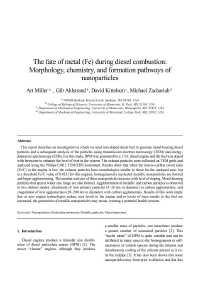Mining Publication: The Fate of Metal (Fe) During Diesel Combustion: Morphology, Chemistry, and Formation Pathways of Nanoparticles
Original creation date: April 2007
This report describes an investigation in which we used iron-doped diesel fuel to generate metal-bearing diesel particles and a subsequent analysis of the particles using transmission electron microscopy (TEM) and energy-dispersive spectroscopy (EDS). For this study, DPM was generated by a 1.5-L diesel engine and the fuel was doped with ferrocene to enhance the level of iron in the system. The exhaust particles were collected on TEM grids and analyzed using the Philips CM12 TEM/EDS instrument. Results show that when the iron-to-carbon (soot) ratio (Fe/C) in the engine is low, the exhaust particles have morphologies similar to those for the undoped case, but at a threshold Fe/C value of 0.013 (for this engine), homogeneously nucleated metallic nanoparticles are formed and begin agglomerating. The number and size of these nanoparticles increase with level of doping. Metal-bearing particles that span a wider size range are also formed. Agglomeration of metallic and carbon particles is observed in two distinct modes: attachment of iron primary particles (5-10 nm in diameter) to carbon agglomerates, and coagulation of iron agglomerates (20-200 nm in diameter) with carbon agglomerates. Results of this work imply that as new engine technologies reduce soot levels in the engine and/or levels of trace metals in the fuel are increased, the generation of metallic nanoparticles may ensue, creating a potential health concern
Authors: AL Miller, GG Ahlstrand, DB Kittelson, MR Zachariah
Peer Reviewed Journal Article - April 2007
NIOSHTIC2 Number: 20032036
Combust Flame 2007 Apr; 149(1-2):129-143
See Also
- Aerosols Emitted in Underground Mine Air by Diesel Engine Fueled with Biodiesel
- AQE - Air Quantity Estimator - 1.0.3
- A Computer Software Program that Estimates Air Quantity Requirements in Large Opening Stone Mines
- Diesel Exhaust Aerosol, Review of Measurement Technology
- Effectiveness of Iron-Based Fuel Additives for Diesel Soot Control
- The Effects of Water Emulsified Fuel on Diesel Particulate Matter Concentrations in Underground Mines
- Morphological and Elemental Classification of Freshly Emitted Soot Particles and Atmospheric Ultrafine Particles using the TEM/EDS
- Real-Time Estimation of Elemental Carbon Emitted from a Diesel Engine
- Sampling Results of the Improved SKC® Diesel Particulate Matter Cassette
- Technology News 514 - The Air Quantity Estimator (AQE): A New Computer Software Tool for Large-opening Mine Ventilation Planning
- Content source: National Institute for Occupational Safety and Health, Mining Program


 ShareCompartir
ShareCompartir
